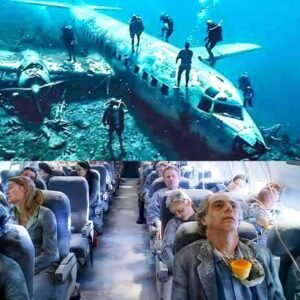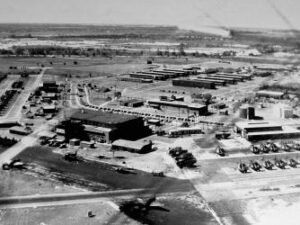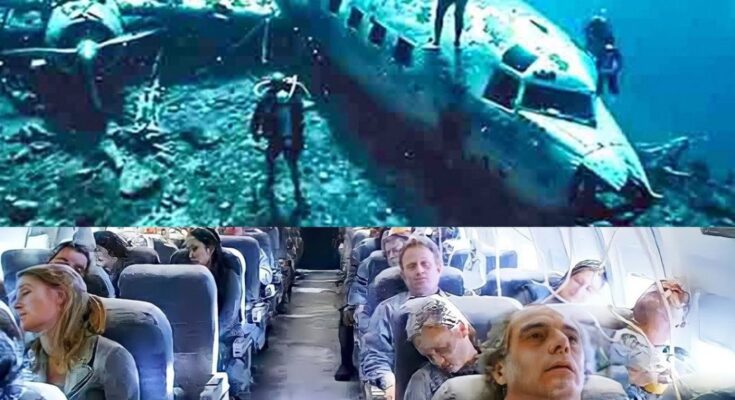
It all started as a regular training flight. On December 5, 1945, at 2:10 p.m., five TBM Avenger planes took off from a Naval Air Station in Ft. Lauderdale, Florida. The group of planes, known as “Flight 19,” was supposed to complete a three-hour training exercise called “Navigation Problem Number One.”
Their flight plan was simple: they would head east from Florida, drop practice bombs at a spot called Hens and Chickens Shoals, then turn north over Grand Bahama Island, and finally turn southwest to return to base. Most of the planes had three crew members, and all the pilots had about 300 hours of flight experience. The flight leader was Lieutenant Charles C. Taylor, an experienced pilot who had fought in World War II.
At first, everything went smoothly. Flight 19 dropped their bombs on target at Hens and Chickens Shoals around 2:30 p.m. But as they turned north for the next part of their journey, something strange happened. Taylor thought his plane’s compass was broken and that they were flying in the wrong direction. Things got worse when bad weather rolled in, with rain, strong winds, and heavy clouds. The group became disoriented. One of the pilots said over the radio, “I don’t know where we are. We must have gotten lost after that last turn.”
Compass problems and confusion
Lieutenant Robert F. Cox, another Navy flight instructor flying near the Florida coast, heard the Flight 19 radio messages. He quickly informed the air station about the issue and contacted Taylor to offer help. Taylor responded, saying, “Both my compasses are out, and I’m trying to find Ft. Lauderdale, Florida. I’m over land, but it’s broken. I’m sure I’m in the Keys, but I don’t know how far down.”
This didn’t add up. Taylor had flown over the Bahamas less than an hour ago, but he now believed they had somehow ended up hundreds of miles away in the Florida Keys. Some people think Taylor got confused because he had recently transferred to Ft. Lauderdale from Miami, possibly mistaking some Bahamian islands for the Florida Keys.

In normal situations, when pilots got lost over the Atlantic, they were instructed to fly west toward the setting sun to find the mainland. However, Lieutenant Taylor believed they might have flown over the Gulf of Mexico instead. To try and find Florida, he made the crucial mistake of steering Flight 19 northeast, which actually took them further out into the ocean.
Some of the other pilots seemed to realize that Taylor was wrong. Over the radio, one pilot expressed frustration, saying, “Dammit, if we would just fly west, we would get home.” But despite their doubts, they continued to follow Taylor’s orders, leading them deeper into trouble.

Eventually, Taylor was convinced to turn the planes westward, but just after 6 p.m., he changed his mind again. “We didn’t go far enough east,” he said, still fearing they were over the Gulf of Mexico. “We may as well just turn around and go east again.” Some pilots likely disagreed with this decision—some reports even suggest one plane might have flown off in a different direction—but most followed Taylor’s lead.
As Flight 19 flew further out to sea, their radio signals grew fainter. With fuel running dangerously low, Taylor prepared his crew for a possible crash landing. “All planes close up tight,” he said. “We’ll have to ditch unless landfall… when the first plane drops below ten gallons, we all go down together.” Soon after, their last transmissions faded into static, and the planes vanished without a trace.

The Navy quickly launched a search for the missing planes. Around 7:30 p.m., two PBM Mariner flying boats took off from an air station north of Ft. Lauderdale to join the search. But just 20 minutes later, one of these planes disappeared from radar, following the same mysterious path as Flight 19.
The wreckage of the Mariner and its 13 crew members was never found. It is widely believed that the seaplane exploded shortly after takeoff. Flying boats were known for being dangerous and were even called “flying gas tanks” due to their tendency to catch fire. This theory was supported by a passing merchant ship that reported seeing a fireball and an oil slick in the ocean.

The next morning, the Navy launched a massive search operation. Over 300 boats and aircraft scoured more than 300,000 square miles of ocean and land for five days, but found nothing. “They just vanished,” said Navy Lieutenant David White. Despite extensive efforts, no bodies or debris were ever found.
A Navy investigation concluded that while Flight 19’s compass malfunction might have caused confusion, it couldn’t explain why the planes became so disoriented. The official report attributed the disappearance to “causes or reasons unknown.”
The mystery of Flight 19 has inspired many theories and speculations. In the 1960s and 70s, writers like Vincent Gaddis and Charles Berlitz popularized the idea that the planes were swallowed by the “Bermuda Triangle,” an area known for strange disappearances and mechanical failures. Some suggest magnetic anomalies, parallel dimensions, or even alien abductions might be responsible. The 1977 film “Close Encounters of the Third Kind” famously depicted Flight 19 as being taken by UFOs and later dropped in Mexico.
There are other oddities surrounding the case. Witnesses claimed that Lieutenant Taylor, who led Flight 19, was late for the briefing and tried to avoid the mission. The reasons for this remain unclear. Additionally, none of the pilots used the rescue radio frequency or their ZBX receivers, which could have helped them find Navy radio towers on land.
The most likely explanation is that Flight 19 ran out of fuel and crashed into the ocean. In 1991, treasure hunters found wreckage of World War II-era planes near Fort Lauderdale, but it turned out to be from a different group of aircraft.
While many believe the wrecks of Flight 19 and the missing rescue plane may still be in the Bermuda Triangle, no definitive evidence of the aircraft or their 27 crew members has ever been found.



